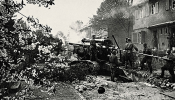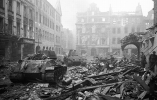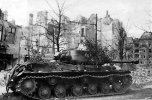-
Sign up or login, and you'll have full access to opportunities of forum.
You are using an out of date browser. It may not display this or other websites correctly.
You should upgrade or use an alternative browser.
You should upgrade or use an alternative browser.
Milestones
- Thread starter admihoek
- Start date

vadim69
Magistrate
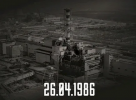
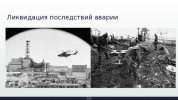 April 26 is the day of the Chernobyl tragedy.
April 26 is the day of the Chernobyl tragedy.Alleged causes of the accident
the experiment was moved to the night and transferred to another shift, which was completely unprepared to carry out the appropriate actions.
the reactor was poorly designed and dangerous;
staff were not informed of the dangers;
personnel made a number of errors and unintentionally violated existing regulations, partly due to a lack of information about the hazards of the reactor;
disabling protection either did not affect the development of the accident or did not contradict
regulatory documents.
Darkprincess69
High Priestess of Slaanesh
I remember watching the news about this a couple of days after it happened (the USSR tried to cover it up for a couple of days until reports of elevated radiation levels started coming in from all over Europe)View attachment 1465318View attachment 1465319April 26 is the day of the Chernobyl tragedy.
Alleged causes of the accident
the experiment was moved to the night and transferred to another shift, which was completely unprepared to carry out the appropriate actions.
the reactor was poorly designed and dangerous;
staff were not informed of the dangers;
personnel made a number of errors and unintentionally violated existing regulations, partly due to a lack of information about the hazards of the reactor;
disabling protection either did not affect the development of the accident or did not contradict
regulatory documents.
To be completely fair to the workers, the regulations regarding operation of the power station were not written in a way that would have helped to negate the inherent instability of the RBMK reactor design. Incidentally another reactor of the same basic type underwent a partial meltdown in 1975 at a powerplant just outside of Leningrad (now St Petersburg), and yet another at Chernobyl in 1982 - just four years before the one that we all know about.
The Leningrad meltdown was the very first reactor of the RBMK design and became operational in 1973, and produced around 925Mw of electricity for a thermal output of around 3200Mw, making the reactor just under 35% efficient, which by nuclear reactor standards isn't too bad actually - of course more modern designs are a bit more efficient than this but nowhere hear as efficient as nuclear fusion which, as we have been continuously reminded for the last 60-odd years, is just 20 years away

The big problem with the RBMK design is that it used light water ie. just H2O - the "normal" water that comes out of your tap - albeit usually filtered a bit - rather than D2O, or heavy water which is somewhat complicated and expensive to produce in sufficient quantities but works much better as a moderator for nuclear reactions, requiring the use of a graphite moderator in order to make the reactor effective. The combination of the graphite moderator and the light water coolant is unique to the RBMK and results in a reactor with what is known as a positive void coefficient, which basically means that there is an ever-present danger of thermal runaway if the reactor gets too hot and all of the water boils off as steam - this reduces the cooling effect and the reactor core, with the moderator and fuel rods will get hotter and hotter until they melt. Because of this, a highly critical balancing act is needed to ensure that enough water gets turned into steam to drive the generators, but not so much that is leaves the reactor with insufficient cooling. There is a very narrow window for safe operation of this type of reactor, leaving it highly prone to overheating events.
Conversely, modern PWR (Pressurised Water Reactor) designs are inherently much safer because although they can also use light water as a coolant, they don't (usually) have a graphite moderator, so all the moderation is done by the water itself, and as the water boils and turns into steam, it becomes less effective as a moderator, thus slowing down the nuclear reactions and thus lowering the power output, so that if the reactor gets too hot, the moderation effect reduces the power level causing it to start cooling down, so to an extent the reaction is inherently much more stable, as thermal runaway is much less likely (not impossible of course - Three Mile Island comes to mind - but one hell of a lot better than the RBMK design.
So why did the USSR go with the RBMK?
In a word... Cost.
In order to use a light water coolant without a graphite moderator in general requires the use of highly enriched Uranium in the fuel rods, which is very expensive and difficult (as well as very time consuming) to produce. The RBMK on the other hand, could use low-enrichment Uranium (enriched to just 2% in the case of the Leningrad and Chernobyl reactors), making it much cheaper to operate, as the fuel rods could be produced for a tiny fraction of the cost.
The RBMK design was also significantly cheaper and quicker to build, which was ideal as the USSR desperately tried to catch up with Western nuclear power (and of course these reactors not only produce energy, but also create Plutonium, a vital component of nuclear weapons, as a waste product...
Unfortunately cutting corners and cheaping out rarely turns out well, and Chernobyl is a textbook example of this

The worst thing about both of these earlier meltdowns is that, in the Soviet culture of the time, any incident at a nuclear powerplant was immediatelt classified as a state secret and thus none of the other RBMK operators were ever aware that these incidents had taken place, so the lessons learned from them never made their way into training programmes for future operators

And we all know how that turned out

Loxuru
Graf von Kreuzigung
Another problem that was mentioned at the time was, that Soviet nuclear plants often had no protective housing the way the western were built, with a concrete 'bunker' over the reactor.Unfortunately cutting corners and cheaping out rarely turns out well, and Chernobyl is a textbook example of this
As far as I recall too (correct me if I am wrong), this was the experiment : engineers wanted to test whether a reactor, shutting down during an emergency, could still produce useful electricity (for keeping the emergency under control).
The experiment could only be carried out when the reactor concerned would be intentionally shut down, for a maintenance operation. So, they had only a short time window.
During previous similar tests, however, safety infrastructure was automatically activated, spoiling the experiment.
Hence, it was decided to switch off these safety systems, so they could not interfere.
But, indeed, the engineers were not familiar with the hazards of the reactor, which went unexpectedly out of control, no more contained by, among which, the control rods, which should have absorbed the excess neutrons emitted by the reactor.
Darkprincess69
High Priestess of Slaanesh
Yeah - that's a bit like like replacing a fuse with a piece of tinfoilHence, it was decided to switch off these safety systems, so they could not interfere.

Or screwing down the safety valve on a boiler - Did you ever catch the episode of Mythbusters when they did that?
it also led to independence for the Portuguese colonies: Angola, Mozambique and Guinea-Bissau,Fifty years ago, on 25th of April 1974, a military coup (the “Carnation Revolution”) overthrew the Portuguese dictator Marcello Caetano. It was the onset of a few years of political instability in what was before one of Western Europe’s remaining dictatorships. But ultimately, Portugal has evolved afterwards to a stable parliamentary democracy. Within two years of the coup, the other remaining dictatorships, Spain and Greece, would also start such a transformation to democracy.
wulf
God-Emperor
A very informative piece. Thank you.I remember watching the news about this a couple of days after it happened (the USSR tried to cover it up for a couple of days until reports of elevated radiation levels started coming in from all over Europe)
To be completely fair to the workers, the regulations regarding operation of the power station were not written in a way that would have helped to negate the inherent instability of the RBMK reactor design. Incidentally another reactor of the same basic type underwent a partial meltdown in 1975 at a powerplant just outside of Leningrad (now St Petersburg), and yet another at Chernobyl in 1982 - just four years before the one that we all know about.
The Leningrad meltdown was the very first reactor of the RBMK design and became operational in 1973, and produced around 925Mw of electricity for a thermal output of around 3200Mw, making the reactor just under 35% efficient, which by nuclear reactor standards isn't too bad actually - of course more modern designs are a bit more efficient than this but nowhere hear as efficient as nuclear fusion which, as we have been continuously reminded for the last 60-odd years, is just 20 years away
The big problem with the RBMK design is that it used light water ie. just H2O - the "normal" water that comes out of your tap - albeit usually filtered a bit - rather than D2O, or heavy water which is somewhat complicated and expensive to produce in sufficient quantities but works much better as a moderator for nuclear reactions, requiring the use of a graphite moderator in order to make the reactor effective. The combination of the graphite moderator and the light water coolant is unique to the RBMK and results in a reactor with what is known as a positive void coefficient, which basically means that there is an ever-present danger of thermal runaway if the reactor gets too hot and all of the water boils off as steam - this reduces the cooling effect and the reactor core, with the moderator and fuel rods will get hotter and hotter until they melt. Because of this, a highly critical balancing act is needed to ensure that enough water gets turned into steam to drive the generators, but not so much that is leaves the reactor with insufficient cooling. There is a very narrow window for safe operation of this type of reactor, leaving it highly prone to overheating events.
Conversely, modern PWR (Pressurised Water Reactor) designs are inherently much safer because although they can also use light water as a coolant, they don't (usually) have a graphite moderator, so all the moderation is done by the water itself, and as the water boils and turns into steam, it becomes less effective as a moderator, thus slowing down the nuclear reactions and thus lowering the power output, so that if the reactor gets too hot, the moderation effect reduces the power level causing it to start cooling down, so to an extent the reaction is inherently much more stable, as thermal runaway is much less likely (not impossible of course - Three Mile Island comes to mind - but one hell of a lot better than the RBMK design.
So why did the USSR go with the RBMK?
In a word... Cost.
In order to use a light water coolant without a graphite moderator in general requires the use of highly enriched Uranium in the fuel rods, which is very expensive and difficult (as well as very time consuming) to produce. The RBMK on the other hand, could use low-enrichment Uranium (enriched to just 2% in the case of the Leningrad and Chernobyl reactors), making it much cheaper to operate, as the fuel rods could be produced for a tiny fraction of the cost.
The RBMK design was also significantly cheaper and quicker to build, which was ideal as the USSR desperately tried to catch up with Western nuclear power (and of course these reactors not only produce energy, but also create Plutonium, a vital component of nuclear weapons, as a waste product...
Unfortunately cutting corners and cheaping out rarely turns out well, and Chernobyl is a textbook example of this
The worst thing about both of these earlier meltdowns is that, in the Soviet culture of the time, any incident at a nuclear powerplant was immediatelt classified as a state secret and thus none of the other RBMK operators were ever aware that these incidents had taken place, so the lessons learned from them never made their way into training programmes for future operators
And we all know how that turned out
My heart goes out to the unfornate souls that had to deal with the aftermath of that faulty judgement and clean up the mess.
wulf
God-Emperor
I watched the episode where they blocked the relief valve on a standard 45gal household water heater. They had built a small house with the same construction materials one would find in a modern home, then turned on the water heater. The inevitable explosion literally launched the appliance through the roof, and a few stories higher on top of that.Yeah - that's a bit like like replacing a fuse with a piece of tinfoil
Or screwing down the safety valve on a boiler - Did you ever catch the episode of Mythbusters when they did that?
Loxuru
Graf von Kreuzigung
Yes. Portugal had been the first European country to establish colonies, in the fifteenth century, and was in the 1970's the last one to have a colonial empire. The colonial wars it waged, together with a corporatist economy, that was in reality in the hands of a few oligarch-like families, friendly to the dictatorial regime, had impoverished the country, and actually made it by far the poorest in Western Europe at the time of the revolution (neighbouring dictator Franco of Spain had at least managed in the 1960's to make his country attractive for mass tourism to the Costa's, generating substantial economical profits)..it also led to independence for the Portuguese colonies: Angola, Mozambique and Guinea-Bissau,
Darkprincess69
High Priestess of Slaanesh
Yeah - especially the first fire crew on the scene who were not even told that there was a radiation hazard, with the result that none of them had protective clothing and were not limited in how much time they were able to spend on site, resulting in a great many of them suffering a horrible death due to radiation sicknessA very informative piece. Thank you.
My heart goes out to the unfornate souls that had to deal with the aftermath of that faulty judgement and clean up the mess.

Darkprincess69
High Priestess of Slaanesh
Yeah, that's the one I was referring too. In fact the myth that they were testing was the one that claimed that an exploding boiler could launch through the roof - I think even the Mythbusters crew were surprised at how much force was unleashed there.I watched the episode where they blocked the relief valve on a standard 45gal household water heater. They had built a small house with the same construction materials one would find in a modern home, then turned on the water heater. The inevitable explosion literally launched the appliance through the roof, and a few stories higher on top of that.
Never underestimate the power of a steam explosion - getting back to Chernobyl, it was this very phenomenon that was not only able to destroy the reactor building, but also to launch the enormous steel cover plate, which weighed several thousand tons, over 50 feet into the air!

Loxuru
Graf von Kreuzigung
A proces contributing to the force of the explosions, was the build-up of hydrogen gas, due to chemical reactions of the water molecules of the hot steam caused by the high temperatures. So, the steam explosion went along with a hydrogen explosion.Yeah, that's the one I was referring too. In fact the myth that they were testing was the one that claimed that an exploding boiler could launch through the roof - I think even the Mythbusters crew were surprised at how much force was unleashed there.
Never underestimate the power of a steam explosion - getting back to Chernobyl, it was this very phenomenon that was not only able to destroy the reactor building, but also to launch the enormous steel cover plate, which weighed several thousand tons, over 50 feet into the air!
Hugin&Munin
Presenter Of Images
View attachment 1465318View attachment 1465319April 26 is the day of the Chernobyl tragedy. Alleged causes of the accident the experiment was moved to the night and transferred to another shift, which was completely unprepared to carry out the appropriate actions. the reactor was poorly designed and dangerous; staff were not informed of the dangers; personnel made a number of errors and unintentionally violated existing regulations, partly due to a lack of information about the hazards of the reactor; disabling protection either did not affect the development of the accident or did not contradict regulatory documents.
That's right, and we in the GDR were told at the time that the radioactive clouds coming from the east somehow jumped over the GDR without leaving any radioactive fallout behind. LOL
After the disaster, sheep in Wales and Cumbria had to be tested for radiation, if levels were too high they were isolated and couldn't be sold until the acceptable level was found. Although the restrictions gradually eased, they were not finally lifted until 2012!
Loxuru
Graf von Kreuzigung
So, that explains why my woolen sweater gave that strange greenish glow in the dark!?After the disaster, sheep in Wales and Cumbria had to be tested for radiation, if levels were too high they were isolated and couldn't be sold until the acceptable level was found. Although the restrictions gradually eased, they were not finally lifted until 2012!
Migoz2
Senator
Except that, strangely, it was areas around nuclear power/processing plants that had the highest levels of radiation. Certainly, in Cumbria, it turned out that at least 50% of the contamination levels predated Chernobyl and were the result of undeclared major incidents at Windscale (now Sellafield).After the disaster, sheep in Wales and Cumbria had to be tested for radiation, if levels were too high they were isolated and couldn't be sold until the acceptable level was found. Although the restrictions gradually eased, they were not finally lifted until 2012!
Hugin&Munin
Presenter Of Images
That's the problem with radiation, you can't see it, you can't hear it, you can't taste it or smell it and by the time you notice the effects, it's already too late.Except that, strangely, it was areas around nuclear power/processing plants that had the highest levels of radiation. Certainly, in Cumbria, it turned out that at least 50% of the contamination levels predated Chernobyl and were the result of undeclared major incidents at Windscale (now Sellafield).
Yes, that's very likely. And Wylfa on Anglesey likewise. Trouble is, the nuclear power stations are sited on the west coast, where the prevailing winds carry any contamination inland. And Windscale - 'windy shieling' - should have been a health warning!Except that, strangely, it was areas around nuclear power/processing plants that had the highest levels of radiation. Certainly, in Cumbria, it turned out that at least 50% of the contamination levels predated Chernobyl and were the result of undeclared major incidents at Windscale (now Sellafield).
Hugin&Munin
Presenter Of Images
On April 29, 1945, US troops liberated the Dachau concentration camp, approximately 20 kilometers from Munich. The US soldiers are able to rescue 70,000 remaining prisoners from the camp. The camp was built on the site of a former ammunition factory just a few weeks after the National Socialists came to power in 1933 on the instructions of Heinrich Himmler, then police chief in Munich. Initially, mainly political opponents were imprisoned in Dachau, later also Jews and other persecuted minorities. By 1945, at least 200,000 people were imprisoned in Dachau and more than 41,000 died. The camp is notorious for its brutal punitive regime: jurisdiction in the camp was exclusively under the control of the commandant, who could arbitrarily decide on the death of the prisoners. There has been a concentration camp memorial at the site of the former camp since 1965.


